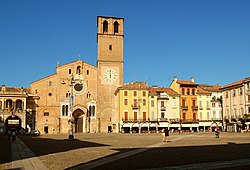Lodi is a city in Southern Lombardy. Lodi is counted among the cities of art of the Po Valley and offers as its main inspiration the presence of some important monuments, including the Cathedral, the Tempio Civico dell'Incoronata, the church of San Francesco, the church of Sant'Agnese and Palazzo Mozzanica.
Understand
[edit]
It is the capital of the vast Lodigiano area, a flat territory in the lower Po area of Lombardy. The territory of Lodi is located in the central-southern part of Lombardy, in the area known as the "lower plain". The oldest part of the city stands on the Eghezzone hill, an approximately trapezoidal hill located on the right bank of the Adda river. The municipal territory is crossed by the Adda and numerous other waterways.
History
[edit]Lodi's origins lie in the destruction of Laus Pompeia, born as a Roman municipium and later a flourishing medieval village, razed to the ground by the Milanese in 1111. The city was refounded by Emperor Frederick I several kilometers from the original site and from then until Renaissance experienced a long period of prosperity.
Get in
[edit]By car
[edit]Autostrada del Sole: Lodi exit.
By train
[edit]To Lodi station, the S1 line (Saronno-Milan-Lodi) runs one train about every 30 minutes.
By bus
[edit]Service carried out by the LINE company.
Get around
[edit]See
[edit]
The most famous city monument dates back to the Renaissance period: the Civic Temple of the Beata Vergine Incoronata, recognized as one of the greatest masterpieces of the Lombard Renaissance. The notable Romanesque-Gothic Cathedral and the Broletto overlook the elegant Piazza della Vittoria. In Lodi there are numerous other buildings of artistic value, including the Gothic churches of San Francesco and Sant'Agnese, as well as the Romanesque San Lorenzo.
- 1 Duomo di Lodi. Piazza della Vittoria .Built in the 12th century, with Gothic and Renaissance alterations.
- 2 Sanctuary of the Incoronata (Tempio Civico della Beata Vergine Incoronata), Via Incoronata, 25. M 09:00-12:00; Tu-F 09:00-12:00, 15:30-18:00; Sa Su 09:00-12:00, 15:00-18:00. It is one of the jewels of the Lombard Renaissance and was built with an octagonal plan at the end of the 15th century. The Incoronata Treasure Museum is also part of the complex, with free entry from the Incoronata Temple.
- 3 Church of San Francesco, Via San Francesco. Gothic construction dating back to the 13th-14th century.
- 4 Civic Museum (Museo civico), Corso Umberto I, 63, ☏ +39 0371 442306. It collects archaeological finds from the Lodi Vecchio area and paintings from the Lodi school.
- 5 Visconti Castle (Castello Visconteo). Medieval construction that served as a defensive fortress. It cannot be visited, as it is the headquarters of the Police Headquarters.
- 6 Palazzo Mozzanica-Varesi, Via XX Settembre, corner via Volturno. It is one of the most important historic buildings in Lodi, built in the 14th century.
Do
[edit]Buy
[edit]Eat
[edit]Drink
[edit]Sleep
[edit]Connect
[edit]Go next
[edit]- Lodi Vecchio — about 7 km from the capital, the ancient Laus Pompeia was located near today's Lodi Vecchio; the village was located on the confluence of the roads that from Placentia (Piacenza) and Acerrae (Pizzighettone) led to Mediolanum (Milan), and at the crossing point with the road that from Ticinum (Pavia) continued to Brixia (Brescia).
- Crema — its Cathedral and the church of Santa Maria della Croce are the main points of interest; the city was in possession of the Serenissima for 400 years, a period from which it retains many architectural influences and part of the Venetian walls.


